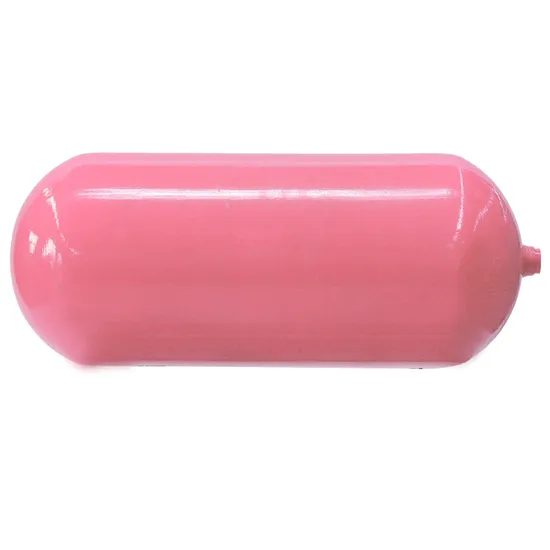
101L Type 1 CNG Cylinders 406mm Wall Thickness Industrial Use for Car
| US$20.00-100.00 | 100 Pieces (MOQ) |
Basic Info.
Function
Storage Pressure Vessel
Application
Gas
Material
37mn
Pressure
10.0MPa≤p<100.0MPa
Storage Medium
Oxygen
Pressure Level
High Pressure (10.0MPa≤p<100.0MPa)
Condition
New
Certificate
ISO9001
Color
Option
Transport Package
Nacked
Specification
6M3
Trademark
FM
Origin
Hangzhou
HS Code
7311009000
Production Capacity
500000 PCS Per Year
Product Description
The manufacturing process of CNG cylinders1. In the automotive field, compressed natural gas (CNG), as a clean, environmentally friendly and economical fuel, has attracted more and more owners' attention and choice. As the storage device of CNG fuel, vehicle CNG cylinder is an important part of vehicle operation. There are two common process types of automotive CNG cylinders, which are steel inner ring wound cylinders and compressed natural gas cylinders. This article will highlight the differences between these two cylinder processes.
Steel inner bladder ring winding cylinder Steel inner bladder ring winding cylinder is a kind of carbon fiber material winding on the inner wall of the cylinder to form the cylinder process. The main features of this type of cylinder are light weight and high strength. Due to the use of carbon fiber materials, steel annular wound cylinders have lower weight and higher strength than conventional compressed natural gas cylinders.
The manufacturing process of the steel inner ring winding gas cylinder needs to go through the following main steps: First, the selection of high-strength carbon fiber materials, and the lamination and textile of fiber cloth. Second, the inner wall of the cylinder is coated with a colloidal environmentally friendly resin adhesive, and then wrapped around it a carbon fiber fabric. After heat curing treatment and other process steps, the carbon fiber is fixed to the inner wall of the cylinder to form a strong inner liner.
2. Compressed natural gas cylinders Compressed natural gas cylinders are cylinders made of high-strength steel. Compressed natural gas cylinders have higher pressure bearing capacity and better corrosion resistance compared with steel inner ring wound cylinders.
The manufacturing process for compressed natural gas cylinders is relatively simple, but requires strict compliance with a series of manufacturing standards and inspection requirements. The main manufacturing steps include the following aspects: First, the selection of high-strength steel, and the corresponding cutting and forming. Then, anti-corrosion treatment such as rust removal and painting is carried out on the steel surface. Through a series of process steps such as cold drawing, hydroforming and integral welding, a complete compressed natural gas cylinder is formed.
3. Process differences and application scenarios There are certain differences in the process between steel inner ring wound gas cylinders and compressed natural gas cylinders, mainly reflected in the selection of materials and processing technology. The steel inner ring winding gas cylinder is made of carbon fiber material, which has the advantages of lightweight and high strength, and is suitable for use in the automotive field with high lightweight requirements. The compressed natural gas cylinder is made of steel, with higher pressure capacity and better corrosion resistance, suitable for general automotive and commercial vehicle fields.
4. In general, the two cylinder processes have their own advantages and should be selected according to actual needs and application scenarios. For the pursuit of lightweight and high strength vehicles, steel inner ring wound cylinder is an ideal choice; For ordinary use or vehicles with high transportation needs, compressed natural gas cylinders are more suitable.
| NO. | type | raw material | liner diameter | working pressure | thickness | length | weight | quantity(pc) |
| 70L | type 2 | 30CrMO+glass fiber+resin | 356mm | 200bar | 4.8mm | 891mm | 52.2kg | 200 |
>> Hot Water Dispenser Stainless Steel Hot Water Urn Commercial Automatic Coffee Urn
>> High Quality 1: 1 New for Watch 9 Smart Watch Wholesale Smart Device S9 S8 Ultra
>> Automatic Tarpaulin Eyelet Pressing and Punching Machine with Feeding Systems
>> new mini corn thresher small corn husking machine ,corn peeling machine
>> harga jam tangan skmei 1469 gents sports watches silicone strap sport watch
>> RGB Color CPU Air Cooler, Support Both Intel and AMD Cpus, Gamma200 by Gamemax
>> Wet Mining Ball Mill Small Ball Mill for Iron Copper Zinc Silver Ore
>> Cheap Factory Restaurant Hotel Dining Chairs Dine Table Chairs for Sale
>> Static Pressing Hydraulic Pressure Hydraform Brick Making Block Machine Qp900
>> Plastic Egg Tray Package Thermoforming Machine
>> China factory price fiberglass grating FRP Composite Industrial Fibreglass grating floor
>> xiaomi Mijia T100 Sonic Electric Toothbrush Adult Ultrasonic Automatic Toothbrush USB Rechargeable Waterproof Tooth Brush Xiami
>> Wholesale Clothing Mens 100 % Cotton 200 gsm Polo Shirts With Customized Logo Embroidery & Printing Polo Shirt
>> Industrial Vacuum Suction Loading Machine Plastic Hopper Loader
>> Seismic Resistance Durability Custom Adjustable Steel Props Scaffolding
>> High Quality Moving Man Lifting Equipment Aerial Platform Scissor Lift Table 6m
>> Aluminum Window and Door Machine Heavy-Duty Double Cylinder Angle Code Assembly Machine
>> 6m3 Concrete Mixer Construction Machinery Cement Tanker Lightweight Mixers Truck Sinotruk Factory Price
>> Infrared Mat Pemf Mattress with Energy Stones for Physical Recovery Sleep
>> High-Speed Efficient Stone Processing Machine for Sintered Countertop Making
>> Straight Knife Blade Auto Sharpening Machine Knife-Machine Nail Cutter Grinde
>> High Performance 35kHz 800W Ultrasonic Seamless Sewing Machine for Non-Woven Fabric
>> Bntet Continuous Coconut Shell Charcoal Making Machine Biochar Making Machine for Carbon Sinks
>> Xianghui Custom Large Capacity Portable Travel Toiletries Storage Wholesale Makeup Cosmetic Bag
>> Wall Decor 3D Marble Tile Self Adhesive PVC Wall Sticker Peel and Stick Wall Tiles Wallpaper
>> Small Bore Drill Machine Z3050X11 Radial Mini Drilling Machine
>> Intelligent File Cabinet, Physical Evidence Management Cabinet, RFID Digital Equipment Cabinet
>> Huge Santa Clause with Gift Inflatable for X′ Mas Decoration 10-40FT
>> Low Price Home Embroidery Machine Single Head Sewing Machine 2025
>> Good Price Food Grade High Purity Sodium Tripolyphosphate STPP with Best Price